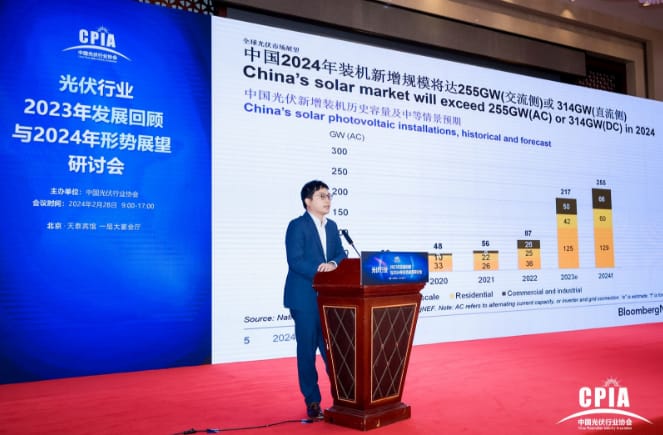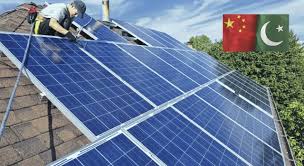
BEIJING, Feb. 29 (INP): Blue panel shining on blue ocean, as Chinese solar PV go global, China Economic Net (CEN) reported on Thursday.
According to CEN, “The winning bid price of domestic photovoltaic modules dropped by more than 40% at the end of 2023 compared with the beginning of the year, falling below 1 yuan/W,” on February 28, the China Photovoltaic Industry Association announced this data at the Photovoltaic Industry 2023 Development Retrospect and 2024 Situation Prospect Seminar hosted by the CPIA.
Is the global PV market already facing overheating or even saturation?
“In 2024, global newly installed PV capacity is expected to grow by about 29%. Meanwhile, according to our estimates, the number of markets with newly installed PV capacity exceeding 1GW in 2024 is expected to be 37,” Tan Youru, Solar Analyst at Bloomberg NEF, made bold prediction.
“As for China, according to Bloomberg NEF estimates, the new installed capacity in 2024 could be reach 255GW (AC side) or 314GW (DC side). It’s too early to talk about saturation.”
Zhang Sen, Secretary-general, the Solar PV Branch at the China Chamber of Commerce for Import and Export of Machinery and Electronic Products, gave a more detailed analysis.
“As volume increases and prices fall, such phased supply and demand imbalance in the industrial chain is a major challenge before us. According to statistics from CCCME, China’s PV product exports in 2023 was USD 47.59 billion, a year-on-year decrease of 4.9%.
Module exports amounted to USD 38.83 billion, a year-on-year decrease of 5.8%. Export volume was 211GW, a year-on-year increase of 36.6%. Nevertheless, what we need to see is that despite facing cyclical fluctuations, this blue ocean still contains wireless opportunities.”
According to CPIA statistics, Europe are still being China’s main PV products export market, accounting for approximately 42% of total exports; Asia’s share has increased from 36% to 40%.
The share of the top ten countries in module exports dropped from 70% to 62%, as well as the number of export markets with more than USD 100 million increased by 7, and the number of export markets with more than USD 500 increased by 4.
At present, the Netherlands, Brazil, Spain and India still maintain their status as the top four export markets, in addition, the markets of Belgium, Saudi Arabia, and Pakistan are among the top ten, all of which obviously showed that the export regions are more diversified.
“Since the energy crisis caused by the Russia-Ukraine conflict in 2022, the European Commission has adopted the Fit For 55 plan to increase the proportion of renewable energy in 2030.
Demand for renewable energy in the EU PV market has surged whip and spur,” Zhang analyzed.
“Outside of Europe, being rich in oil and gas resources, the traditional energy power generation has long dominated the Middle East market, resulting in a single energy structure.
As the demand for energy transformation accelerates, PV demand in the Arab countries has reached approximately 20.5-23.6GW last year.
PV demand in markets led by Turkey, Saudi Arabia, and the United Arab Emirates has skyrocketed. Take the United Arab Emirates as an example. China’s PV module exports to the UAE in 2023 was USD395 million.
As a newly expanded emerging market, cells have grown slightly from USD 09 million in 2022 to USD 12 million in 2023, all of which are just the beginning.
Frankly speaking, there are endless possibilities for Chinese PV companies to go global, not only in Middle East.”
According to Zhang, since 2020, China’s solar PV projects have ushered in a period of rapid development in overseas contract signings.
In 2020, there were 117 projects with an installed capacity of 14.1GW, which has soared to 180 projects in 2023 with an installed capacity of 34GW.
On November 15, 2023, China and the United States issued the Sunnylands Statement on Strengthening Cooperation to Address the Climate Crisis, which proposed that in the critical decade of the 2020s, the two countries will strive to triple the global installed capacity of renewable energy by 2030.
Specifically, by 2030, global PV installed capacity will increase from 1,055 GW in 2022 to 5,457 GW in 2030. “By going global, our blue panel will shining on the blue ocean.”
INP/javed































































































